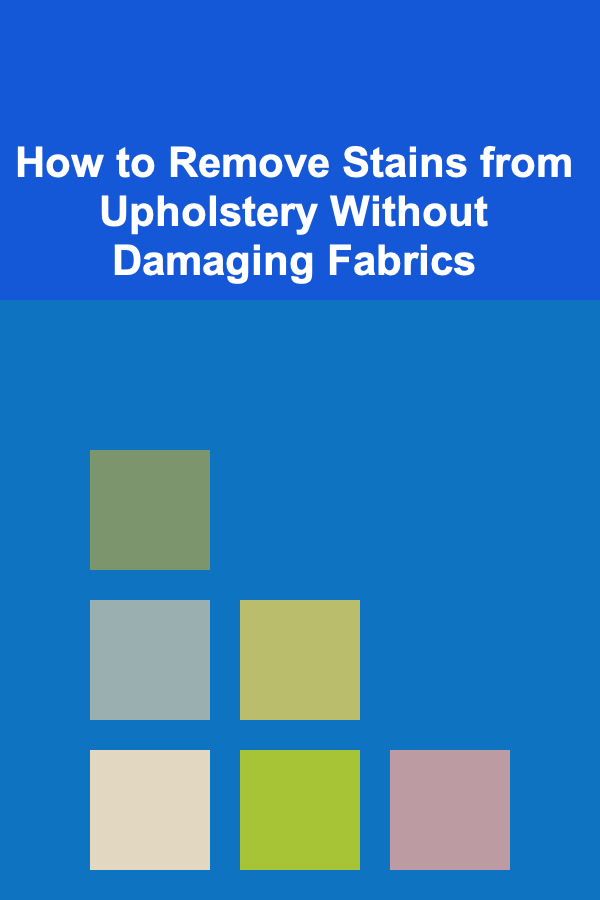
How to Remove Stains from Upholstery Without Damaging Fabrics
ebook include PDF & Audio bundle (Micro Guide)
$12.99$11.99
Limited Time Offer! Order within the next:

Upholstery is an essential part of home decor, enhancing the aesthetic appeal and providing comfort. Whether it's your sofa, armchair, or upholstered dining chairs, they all bear the marks of everyday life. From spills and pet accidents to dirt and oils, stains on upholstery are inevitable. However, the challenge is how to remove those stains without causing damage to the fabric. Using the wrong method or products can result in fading, fabric deterioration, or setting the stain permanently.
In this article, we will explore how to effectively remove stains from upholstery, focusing on the safest and most efficient techniques. We will provide detailed advice on various types of upholstery fabrics, from cotton to microfiber, and outline the best cleaning solutions and methods for different types of stains.
Understanding Upholstery Fabric Types
Before diving into the cleaning techniques, it is essential to understand the different types of upholstery fabrics. Each fabric type has its own characteristics, and some fabrics require more delicate handling than others. Here are some common upholstery fabrics:
1. Cotton
Cotton is a soft and breathable fabric, but it is prone to staining and may shrink when exposed to too much water or high heat. Cotton upholstery can often handle gentle cleaning methods, but care should be taken not to oversaturate the fabric.
2. Linen
Linen has a beautiful, crisp texture and is naturally resistant to mildew. However, it can easily wrinkle and is prone to staining, especially from oils and liquids. Linen should be cleaned with care to avoid damaging its fibers.
3. Microfiber
Microfiber is durable, stain-resistant, and easy to maintain, making it a popular choice for upholstery. It is made of synthetic fibers and is less prone to absorbing stains compared to natural fabrics. However, certain cleaning methods can cause discoloration or damage, so it's important to use the right approach.
4. Leather
Leather upholstery is a luxurious option that requires special care. It is sensitive to moisture and can crack or stain when exposed to harsh cleaning products or water. Leather needs to be cleaned with gentle, leather-safe cleaners.
5. Velvet
Velvet is a luxurious fabric that can be challenging to clean due to its pile structure. Stains on velvet can be absorbed deeply into the fibers, making them harder to remove. Proper care is necessary to avoid crushing the pile or causing permanent damage.
6. Synthetic Fabrics (Polyester, Nylon, etc.)
Synthetic fabrics are durable, stain-resistant, and easy to clean. However, they can sometimes trap dirt and oils, so it's important to clean them regularly. These fabrics generally allow for more flexibility with cleaning methods compared to natural fibers.
Understanding the type of upholstery fabric you are dealing with is crucial to avoid choosing an inappropriate cleaning method that could cause damage.
Types of Stains and How to Treat Them
Stains can vary in origin and severity, ranging from food and beverages to oil and pet accidents. Different stains require different cleaning techniques to ensure the upholstery fabric isn't damaged. Below, we will categorize the most common stains and provide strategies for effective removal.
1. Food and Beverage Stains
Food and beverage stains are some of the most common culprits of upholstery stains. These stains often come from coffee spills, wine, juice, chocolate, or grease. They may leave a visible mark, but they are usually easier to treat if handled quickly.
Cleaning Method:
- Blot the stain immediately with a clean cloth or paper towel to absorb as much liquid as possible. Do not rub the stain, as it can cause the liquid to spread and seep deeper into the fabric.
- For water-based stains (e.g., coffee, juice, or soda), mix a solution of mild dish soap and lukewarm water. Use a clean sponge or cloth to blot the solution onto the stain. Rinse with clean water and blot again with a dry cloth to remove excess moisture.
- For grease-based stains (e.g., oil, butter, or chocolate), sprinkle baking soda or cornstarch directly on the stain. Let it sit for 15-20 minutes to absorb the grease, then gently vacuum it off. Follow up with a mild soap solution to clean the remaining stain.
- For red wine or juice stains, immediately sprinkle salt over the stain to absorb the liquid. Then, gently blot the stain with cold water, followed by applying a mixture of water and vinegar. Continue blotting until the stain is removed.
2. Ink Stains
Ink stains are notoriously stubborn, but they can often be removed without damaging the upholstery if treated quickly.
Cleaning Method:
- Blot the ink stain with a dry cloth to absorb any excess ink, but avoid rubbing.
- Mix a solution of equal parts rubbing alcohol and water. Test the solution on an inconspicuous area of the upholstery to ensure it does not damage or discolor the fabric.
- Using a clean cloth, gently blot the ink stain with the alcohol-water solution. Continue blotting until the stain starts to fade.
- Once the ink is removed, clean the area with plain water to remove any residue, then blot it dry.
3. Pet Stains
Pet stains, particularly urine, can not only stain but also leave a lingering odor. These stains must be treated promptly to prevent them from setting into the fabric and causing lasting damage.
Cleaning Method:
- Blot the stain with paper towels or a clean cloth to absorb as much moisture as possible.
- Mix a solution of 1 part white vinegar to 2 parts water and add a teaspoon of baking soda. Spray the solution directly onto the stain and allow it to sit for 15 minutes.
- Blot the area with a clean cloth to absorb the moisture. Repeat if necessary, then allow the fabric to air dry.
- To eliminate the odor, sprinkle the area with baking soda after cleaning, let it sit for an hour, and then vacuum it up.
4. Mold and Mildew Stains
Mold and mildew stains are common in bathrooms or damp environments. These stains can be tricky to remove without damaging the fabric, especially if left untreated for a long period.
Cleaning Method:
- Vacuum the area first to remove any loose mold or mildew.
- Mix a solution of equal parts white vinegar and water. Test it on a small, hidden area of the upholstery before applying it to the stain.
- Spray the solution on the affected area, then blot with a clean cloth to absorb the mold and mildew.
- If necessary, mix a paste of baking soda and water and apply it to the stain. Let it sit for 30 minutes before blotting and rinsing the area.
5. Blood Stains
Blood stains can be challenging, but the sooner you act, the better your chances of successfully removing the stain without damaging the fabric.
Cleaning Method:
- Blot the stain immediately with cold water and a clean cloth. Avoid using hot water, as it can set the blood stain.
- For stubborn blood stains, apply a small amount of hydrogen peroxide directly to the stain. Let it sit for a few minutes, then blot with a clean cloth.
- Rinse the area with cold water, then dry with a towel.
General Upholstery Cleaning Tips
While removing stains is essential, general cleaning and maintenance are crucial for keeping your upholstery in top condition. Here are some general upholstery cleaning tips to help preserve your fabric:
1. Vacuum Regularly
Dust, dirt, and pet hair can accumulate on upholstery, making the fabric look worn and dirty over time. Regular vacuuming helps prevent this buildup and keeps your upholstery looking fresh. Use an upholstery attachment or a handheld vacuum for hard-to-reach areas.
2. Test Cleaning Solutions First
Before applying any cleaning solution to the entire stain or fabric, always perform a spot test on an inconspicuous area of the upholstery. This will ensure that the cleaning solution doesn't cause discoloration, fading, or fabric damage.
3. Avoid Excessive Water
Using too much water can cause upholstery to become waterlogged, which may lead to fabric damage or mildew growth. Always use a minimal amount of water, especially on delicate fabrics.
4. Use Upholstery-Specific Cleaners
There are many upholstery-specific cleaners available in the market that are designed to safely clean various fabric types. Consider using these cleaners when needed, especially for challenging stains, to prevent fabric damage.
5. Consider Professional Cleaning
If the stain is particularly stubborn or your upholstery is delicate, it may be worth considering professional cleaning services. Professionals have specialized tools and products designed to remove deep stains while preserving the integrity of the fabric.
Conclusion
Removing stains from upholstery without causing damage requires understanding the fabric type, using the correct cleaning method, and acting quickly. By following the right procedures, you can effectively tackle food stains, ink stains, pet accidents, and more while preserving the appearance and quality of your furniture.
Regular maintenance, such as vacuuming and spot cleaning, is crucial to ensure your upholstery stays in excellent condition over time. By investing a little extra care into your upholstery, you can extend the life of your furniture and maintain a fresh, clean look for years to come.
Reading More From Our Other Websites
- [Home Renovating 101] How to Protect Your Investment: A Beginner's Guide to Basement Waterproofing Maintenance
- [Personal Care Tips 101] How to Store Your Shaving Cream for Maximum Freshness and Longevity
- [Survival Kit 101] The Ultimate Multi‑Tool Survival Kit for Urban Survivalists Preparing for Civil Unrest
- [Trail Running Tip 101] Gear Up: Essential Equipment and Tech Tips for Safe Trail Running Competition
- [Simple Life Tip 101] Best Strategies for Reducing Decision Fatigue in a Simple Lifestyle
- [Paragliding Tip 101] Soaring to Glory: Highlights from the Latest Paragliding World Championships
- [Organization Tip 101] How to Batch Cook and Freeze Meals for Busy Weekdays
- [Reading Habit Tip 101] Tech-Powered Reading: Apps and Tools That Elevate Your Comprehension Skills
- [Home Cleaning 101] How to Clean a Washing Machine: Maintaining Efficiency and Hygiene
- [Home Pet Care 101] How to Provide Mental Stimulation for Your Indoor Pet

A Beginner's Guide to Utilizing Digital Banking and Budgeting Tools for Smart Spending
Read More
How to Prevent Water Damage With Regular Home Inspections
Read More
How to Train Your Team to Use Automated Tools Efficiently
Read More
How to Use a Closet System to Declutter Your Home
Read More
How to Use Hidden Storage Solutions in Your Living Room
Read More
How to Negotiate a Better Investment Banking Bonus
Read MoreOther Products

A Beginner's Guide to Utilizing Digital Banking and Budgeting Tools for Smart Spending
Read More
How to Prevent Water Damage With Regular Home Inspections
Read More
How to Train Your Team to Use Automated Tools Efficiently
Read More
How to Use a Closet System to Declutter Your Home
Read More
How to Use Hidden Storage Solutions in Your Living Room
Read More